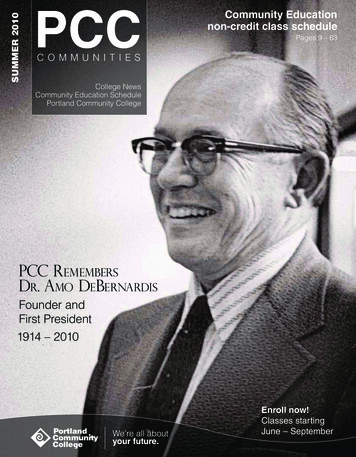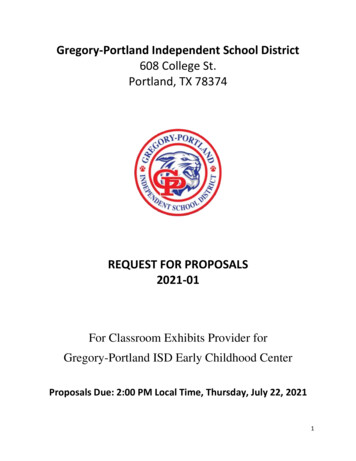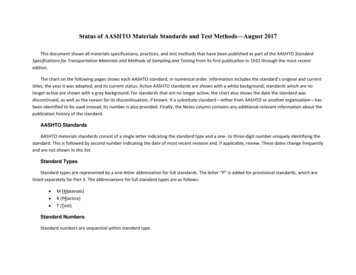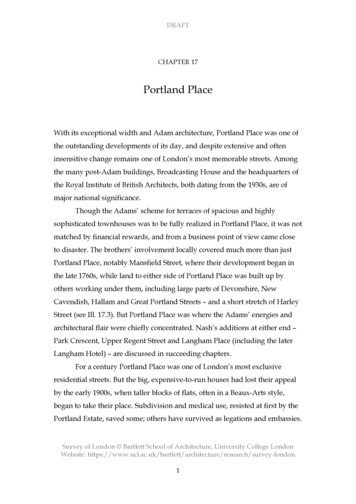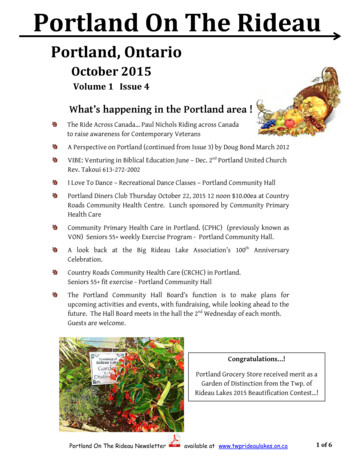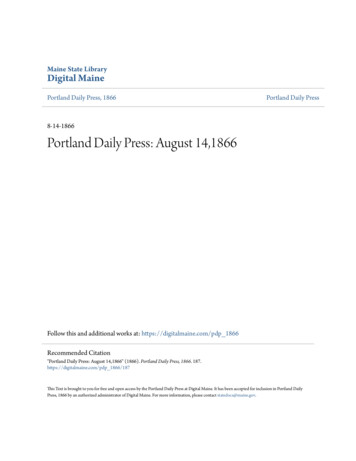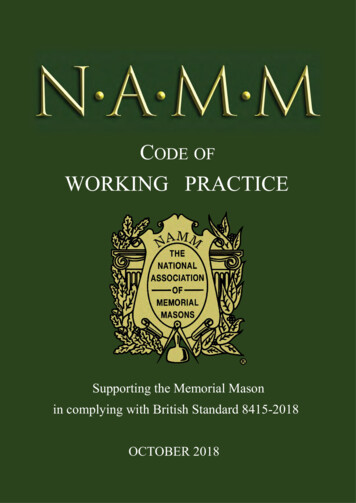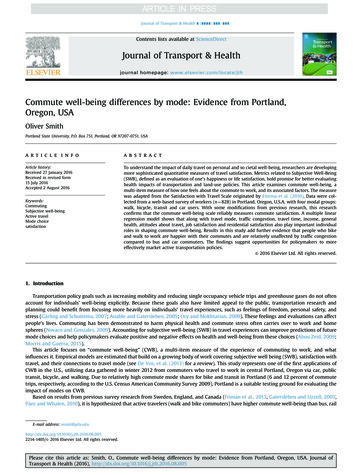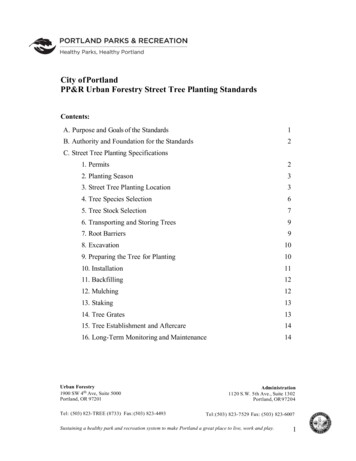
Transcription
City of PortlandPP&R Urban Forestry Street Tree Planting StandardsContents:A. Purpose and Goals of the Standards1B. Authority and Foundation for the Standards2C. Street Tree Planting Specifications1. Permits22. Planting Season33. Street Tree Planting Location34. Tree Species Selection65. Tree Stock Selection76. Transporting and Storing Trees97. Root Barriers98. Excavation109. Preparing the Tree for Planting1010. Installation1111. Backfilling1212. Mulching1213. Staking1314. Tree Grates1315. Tree Establishment and Aftercare1416. Long-Term Monitoring and Maintenance14Urban Forestry1900 SW 4th Ave, Suite 5000Portland, OR 97201Tel: (503) 823-TREE (8733) Fax: (503) 823-4493Administration1120 S.W. 5th Ave., Suite 1302Portland, OR 97204Tel: (503) 823-7529 Fax: (503) 823-6007Sustaining a healthy park and recreation system to make Portland a great place to live, work and play.1
Contents (continued):D. Definitions15E. Resources18Appendix A: Street tree spacing diagram19Appendix B: Root barrier installation at sidewalk19Appendix C: Street tree planting diagram20City of Portland Street Tree Planting Standards
A. Purpose and Goals of the StandardsStreet trees are important to the identity of Portland and for the quality of life of Portlandresidents. Street trees are part of our physical infrastructure and as such must be cared for asa physical asset. Proper planting and establishment are key factors in maximizing long-termtree survival as well as the benefits of trees.This document contains planting standards to inform residents, contractors, business owners,City staff, and others of acceptable street tree planting activities within the city of Portland,Oregon. Any person planting a street tree shall do so in an appropriate manner, in order toincrease the likelihood of successful tree establishment and survival.Any person who plants a tree in the City of Portland right-of-way is required to followthe standards described in this document. If these standards are not followed, the treeplanter and/or the adjacent property owner may be subject to corrective action and/orpenalties under the authority of Portland City Code Title 11 Trees.There are three main goals for the Street Tree Planting Standards. These goals directly supportthe 2004 Urban Forestry Management Plan and the 2007 Urban Forest Action Plan.Goal 1: Promote proper stewardship of the urban forest by informing people how toproperly plant and establish treesCare of the urban forest by many knowledgeable people improves and enhances thequality of the urban forest. Many people have the chance to be a steward of the urbanforest by being a volunteer, property owner, or resident, or as part of an agency, nongovernmental organization, or business. Informing Portland residents of tree carestandards can lead to more conscientious stewardship.Goal 2: Increase the benefits of the urban forest by planting the right tree in the rightplace, establishing healthy trees, and promoting increased canopy coverage due to highsurvival rates for street treesTrees provide the city with numerous benefits, such as reduced stormwater runoff,decreased air pollution, urban heat island mitigation, wildlife habitat, and aestheticbenefits. Proper species selection, planting and care of trees when they are young arestrong determining factors in the lifespan and maintenance needs of trees. By ensuringthe best practices for planting and care of trees are followed, the urban canopy willproduce maximum benefits.Goal 3: Enhance the resiliency of Portland’s urban forest by increasing the age diversityas well as the species diversity of the urban canopyDiversity in the urban forest increases resiliency by reducing both climate-related andbiological risks, namely invasive pests and disease such as Dutch elm disease, Asianlonghorned beetle, and emerald ash borer. Planting new trees and replacing senescenttrees helps promote age diversity within the urban tree population. Age diversity canreduce the potential of having to replace large portions of the urban canopy duringsingle events, helping to ensure consistent canopy cover throughout the city.City of Portland Street Tree Planting Standards - update 2-26-201
B. Authority and Foundation for the StandardsPortland Parks & Recreation City Nature Urban Forestry (Urban Forestry) issues permits forall street tree planting within the City of Portland under the regulatory authority of PortlandCity Code Title 11 Trees. This title grants the City Forester the authority to establish standardsfor planting street trees.The City of Portland planting standards reflect industry standards and acceptable bestmanagement practices for planting, as published in the American National StandardsInstitute’s “ANSI A300 Part 6: Tree, Shrub, and Other Woody Plant Maintenance-StandardPractices (Planting and Transplanting)” (2012), the International Society of Arboriculture’s“Best Management Practices: Tree Planting” (2005), and the American Nursery & LandscapeAssociation’s “American Standard for Nursery Stock (ANSI Z60.1-2014).”This document provides standards specific to right-of-way tree planting within the City ofPortland. The City of Portland standards may be more restrictive than those in thepublications above, given the City’s goals of increasing and enhancing the urban forest.Exceptions to these standards can only be granted by the permitting authority.C. Street Tree Planting Specifications1. PermitsPermits are necessary to ensure planting the right tree in the right place. Permits comewith a site inspection by a City of Portland Urban Forestry Tree Inspector to helpdetermine appropriate locations for planting trees as well as the appropriate tree for theplanting site. This guarantees that the trees planted in the right-of-way are suitable for theurban environment and also helps avoid conflicts with existing infrastructure.a.Any person intending to plant a tree in the City right-of-way (i.e. a street tree)shall first obtain a valid permit from Urban Forestry. Street trees shall not beplanted without a valid permit.b.No substitutions shall be made to the specifications of the planting permit withoutthe written consent of the City Forester.c.As part of the permit, the City Forester or the City Forester’s designee shallperform an on-site inspection and mark the street tree planting location.d.All street tree planting sites are subject to inspection before, during, and afterwork is completed.e.All conditions of the permit shall be met, or the permit may be denied or revokedand/or the permittee subject to corrective actions and/or penalties under theauthority of City Code 11.70.City of Portland Street Tree Planting Standards - update 2-26-202
2. Planting SeasonThe time of year a tree is planted can greatly affect the tree’s establishment becausenewly planted trees require water to survive and grow. Planting during the wet, coolmonths will help ensure tree establishment and survival.a.The planting season in Portland extends from October 1 through April 30.Planting during this timeframe is recommended.b.If a permit is issued outside of the planting season, the City Forester may deferplanting until the next planting season in order to promote survivability.3. Street Tree Planting LocationStreet trees are a vital part of public infrastructure, reducing stormwater runoff, reducingheat, enhancing property values, and providing wildlife habitat. However, street treesshare space with other public infrastructure, requiring careful selection of tree plantinglocations in the right-of-way. Progressive planting designs are encouraged to incorporatestreet trees when development occurs. This is another aspect of planting the right tree inthe right place, helping to mitigate infrastructure conflicts and supporting maximum treegrowth and longevity.a.Utility marking: The applicant shall call the Oregon utility notification locatecenter hotline at 811 or 503-246-6699 (local) or 1-800-332-2344 (toll free) to markthe locations of underground utilities before any ground-disturbing activities takeplace.b.Spacing requirements: Mature tree size and planting site size define the minimumtree spacing requirements. Alternative designs may be approved by the CityForester. See Appendix A for a street tree spacing diagram.Definitions: Large planting sites:o Improved sites greater than or equal to 6.0 feet wide withoutoverhead high-voltage wires o Unimproved sites without overhead high-voltage wiresMedium planting sites:o Improved sites greater than or equal to 4.0 feet wide but less than6.0 feet wide with or without overhead high-voltage wireso Improved sites greater than or equal to 6.0 feet wide with overheadhigh-voltage wires o Unimproved sites with overhead high-voltage wiresSmall planting sites:o Improved sites greater than or equal to 3 feet wide but less than 4feet wide with or without overhead high-voltage wiresCity of Portland Street Tree Planting Standards - update 2-26-203
Width is measured perpendicular to the street. If there is a curb, theplanting site is measured from the interior edge of the curb to the closestsidewalk edge.Trees shall be spaced no less than the following distances from existinginfrastructure:i.Fire hydrants: 10’ from fire hydrants.ii. Water meters: 10’ from water meters and water quality sampling stations forlarge planting sites; 5’ for medium and small planting sites.iii. Underground utilities: 5’ from underground utilities, e.g. water pipes.iv. Gas lines: 5’ from gas lines for large and medium planting sites, 3’ for smallplanting sites.v. Intersections: 25’ from a street intersection, measured from the streetside edgeof the curb; street trees located at intersections should follow AmericanAssociation of State Highway and Transportation Officials (AASHTO)requirements for clear site triangles.vi. Driveways, walkways, curb cuts, and alleyways: 5’ from driveways,walkways, curb cuts, alleyways, and paved paths.vii. Stormwater management facilities: for trees outside of stormwatermanagement facilities, 5’ from the outside edge of the stormwatermanagement facility; locations of trees planted within stormwatermanagement facilities shall be determined by the Bureau of EnvironmentalServices and the City Forester.viii. Property lines: 2’ from property lines.ix. Building entrances: Trees should not be planted in front of building entrances.x. Traffic signals: 25’ from traffic signals.xi. Street lights: 25’ from street lights for large and medium planting sites; 15’ forsmall planting sites; 15’ if a narrow-growing tree species or variety of tree isselected.xii. Traffic signs: 20’ from the front of stop signs; 20’ from the front and 5’ from theback of other directional and safety signs, such as yield, pedestrian crossing,school, speed limit, etc. Curvy roads may require additional spacing.xiii. Other signs: 10’ from the front of other signs such as parking, street name, busstop signs, etc. and 5’ from the back of these signs. Curvy roads may requireadditional spacing.xiv. Bus benches and shelters: 5’ from bus stop benches and shelters.xv. Utility poles: 5’ from non-streetlight utility poles.xvi.Guy wires: Trees shall be planted outside of guy wires for large planting siteswithout overhead, high-voltage wires. Trees may be planted inside of guywires for medium and small planting sites and large planting sites withCity of Portland Street Tree Planting Standards - update 2-26-204
overhead, high-voltage wires if the tree is at least 10’ from the anchor and 5’from the pole and provided there is room for the tree to grow around the wire.xvii. Existing trees: 25’ from adjacent trees, measured trunk center point to trunkcenter point.xviii. Overhanging canopy: Street trees should not be planted under existing treecanopy if there will be a conflict as the tree matures. Tree size at maturityshould be considered.xix.Existing landscaping: Existing shrubs, raised beds, pavers, and other landscapingmay be considered when locating a street tree for planting. These items shouldnot prevent a street tree from being planted when required.c.Site size: Trees shall not be planted in planting strips that are less than 3 feetwide, measured from the interior edge of the curb to the sidewalk. The CityForester may approve planting in strips less than 3 feet wide on a case-by-casebasis.d.Stormwater management facilities: The City Forester may approve treeplanting in stormwater management facilities on a case-by-case basis.e.Cutouts: Concrete cutouts may be created in curbtight sidewalks. Cutouts shouldbe as large as possible to provide ample growing space for the tree. Cutouts that areat least 6’x10’ are preferred and encouraged. The minimum standard cutout sizeshall be 4’x6’. The City Forester and City Engineer may make exceptions on acase-by-case basis. When altering a sidewalk, the permit holder shall obtain apermit from the City Sidewalk Department by calling 503-823-1711.f.Curbtight sites: For curbtight sites that do not have room for a cutout but haveright-of-way extending beyond the sidewalk on the property side, trees shouldgenerally be planted no closer than 2’ from the sidewalk. Tree species shall beselected from the largest list appropriate for the site.g.Medians and traffic circles: Tree medians and traffic circles shall be planted incoordination with the Portland Bureau of Transportation (PBOT). Tree species shallbe selected to fit the median or traffic circle width and to reduce interference withtraffic mobility and visibility.h.Unimproved rights-of-way: Unimproved rights-of-way include areas withoutsidewalks and/or curbs.i.Unimproved rights-of-way fall under one of the following two categories:a) Curb no sidewalk – the site has a curb but no sidewalk; right-of-way mayextend beyond the curb on the property sideb) No curb no sidewalk – there may be right-of-way between the street andthe adjacent property; the street may be paved, unpaved, or gravelii. The presence of overhead high-voltage wires, right-of-way width, existingtrees, parking areas, and foreseeable street improvements shall be consideredwhen locating a tree for planting in an unimproved right-of-way site. Thecurrent uses of the site, pedestrian circulation, vehicle circulation, safety, andCity of Portland Street Tree Planting Standards - update 2-26-205
standard setbacks shall also be considered when locating a tree for planting inan unimproved right-of-way site.iii. Trees should be located at least 2’ from the curb on the property side inunimproved right-of-way planting sites with a curb but no sidewalk.4. Tree Species Se lectionDetermining what trees are appropriate for planting in the right-of-way is part of routine,responsible urban forest management. Not all tree species are suitable for the urbanenvironment, so Urban Forestry has developed Approved Street Tree Planting Lists tohelp plant the right tree in the right place. The lists help ensure the species selected forplanting are appropriate for both the specific site and Portland’s urban canopy as a whole,encourage diversity, prevent infrastructure conflicts, and maximize the benefits of theurban canopy.Increasing the diversity of the urban canopy will help protect the forest from significantfuture risks, benefitting the health and resiliency of the urban forest. Species selected forplanting should take into account local tree diversity as well as site conditions such asmicroclimate, site aesthetics, and soil type and condition.a.Species selection: The City Forester shall approve the final species selection fortrees planted in the City right-of-way. Trees should be selected from the ApprovedStreet Tree Planting List that conforms to the planting site width and overheadwires specifications.i.Trees on the Portland Nuisance Plant List shall not be planted in the Cityright-of-way under any circumstance.ii. Any trees planted in environmental (c, p), greenway (n, q, or greenwaysetback and riverward portion of g, i, and r overlay zones), scenic corridors(s), or Pleasant Valley Natural Resource (v) overlay zones shall be nativespecies.b.Approve d Street Tree Planting Lists:i.2.5-2.9 foot planting sites with or without overhead high-voltage power lines*These sites are only granted under special circumstances with approval of theCity Foresterii.3.0-3.9 foot planting sites with or without overhead high-voltage power linesiii. 4.0-5.9 foot planting sites with overhead high-voltage power linesiv. 4.0-5.9 foot planting sites without overhead high-voltage power linesv. 6.0 foot and greater planting sites with overhead high-voltage power linesvi. 6.0-8.4 foot planting sites without overhead high-voltage power linesvii. 8.5 foot and greater planting sites without overhead high-voltage power linesc.Species diversity:i.When a permit holder plants fewer than 8 trees per calendar year, they may allbe the same species.City of Portland Street Tree Planting Standards - update 2-26-206
ii. When a permit holder plants between 8 and 24 trees per calendar year, nomore than 40 percent of the total planted shall be of one species.iii. When a permit holder plants more than 24 trees per calendar year, no morethan 24 percent of the total planted shall be of one species.d.Mature height, spread, and shape of tree: The crown of a tree at maturityshould not be in serious conflict with neighboring structures. Street trees plantedin sites below overhead high-voltage power lines should be selected so they do notgrow into the high-voltage power lines.e.Species selection in unimproved rights-of-way: If there is an adjacent plantingsite on the same side of the block as the unimproved right-of-way planting site, thewidth of the improved site may be used to determine the list for tree species selectionfor the unimproved site. If there is no adjacent planting strip on the same block, thefollowing lists shall be used for tree species selection:i.Unimproved right-of-way sites with overhead high-voltage power lines shallhave tree species selected from the “6 foot and greater with overhead highvoltage power lines” listii. Unimproved right-of-way sites without overhead high-voltage power linesshall have tree species selected from the “8.5 foot and greater withoutoverhead high-voltage power lines” listf.Exceptions: The City Forester may grant exceptions to or require restrictions on:i.The Approved Street Tree Planting Lists;ii. The species diversity requirement, in order to fulfill or complement anadopted street or landscape plan; andiii. The native species planting requirement, when the proposed species of treewill not likely displace native species and site conditions make planting anative tree species infeasible.iv. Exceptions and restrictions shall be made in writing.5. Tree Stock SelectionMature trees are potentially only as good as the nursery stock from which they came.Therefore, it is crucial to carefully select trees for planting that have good form and arefree from insects, disease, damage, and decay. To help the tree survive in the urbanenvironment it is also important to select large-caliper trees. Larger caliper trees have anestablished central leader and typically branch higher, providing necessary clearancesooner than smaller trees. Smaller trees are also more prone to damage and vandalism.Planting larger caliper trees of good nursery stock helps protect the investment in oururban canopy resource.a.Tree caliper: Broadleaf trees shall be at least the minimum caliper size as definedbelow at the time of planting. The City Forester may make exceptions to therequired caliper size on a case-by-case basis. Tree caliper shall be measured at 6inches above the tree’s natural ground line for trees less than or equal to 4 inchescaliper, or at 12 inches for trees greater than 4 inches caliper.City of Portland Street Tree Planting Standards - update 2-26-207
i.Broadleaf tree size requirements:Development typeStreet tree minimumcaliper sizeOne and two family residential1.5 inchesMulti-dwelling residential2.0 inchesAll others2.5 inchesii. Conifer tree size requirements: Conifer trees shall be a minimum of 5 feetin height at time of planting.b.Tree stock: Trees shall be grown and harvested in accordance with the standardsin the American Standard for Nursery Stock (ANSI Z60.1-2014 or the mostcurrent edition). Trees acquired for planting in the City right-of-way shall benursery-grown in a USDA hardiness zone suitable for the region.Trees acquired for planting in the City right-of-way shall exhibit the followingcharacteristics:i.Healthy and vigorous, with trunk and limbs free from insects, disease, defects,injuries, and decayii. Single trunk that is straight, with a well-developed leader and good trunk taperiii. Well-distributed branches that are considerably smaller diameter than thetrunk, with wide-angled branch attachments or branch attachments that areappropriate for the tree form.iv. A fibrous root systemv. Bare root trees: Bareroot trees shall have abundant root growth, with bothlarger anchor roots and smaller fibrous roots. Roots shall not be broken, torn,decayed, or damaged. Bareroot trees shall be planted prior to bud-break.vi. Balled and burlapped (B&B) trees: B&B trees shall have a firm root ball.The root ball shall not be loose, broken, or desiccated. The trunk shall be solidlyattached to the root ball. The root ball shall be large enough to support the treecaliper size. Minimum root ball diameters for selected sizes of shade trees(ANSI Z60.1) shall be:Calipe r(inche s)Minimum root balldiameter (inches)116224332442City of Portland Street Tree Planting Standards - update 2-26-208
vii. Container trees: Roots shall be well-developed enough to hold the pottingsubstrate together. At sale, trees should have been growing in their currentcontainers for approximately one year. The tree shall not be pot bound or havematted or girdling roots. The soil shall not be desiccated.viii. Fabric bag trees: The trunk shall be solidly attached to the root ball. The rootball shall not be broken or desiccated.6. Transporting and Storing TreesOnce a large, healthy, vigorous tree has been purchased, care must be taken whentransporting the tree to the planting site. Digging and transporting stresses the tree andmakes the tree vulnerable to desiccation. Trees wrapped too tightly during transport canlead to sweating. It is important to cover the tree properly during transportation andstorage while ensuring adequate moisture and ventilation. Trees have the best chance forsurvival if they are planted in the same year they are dug.a.Trees should be dug during the tree’s dormant season and dug to retain as manyfibrous roots as possible. Trees shall be transported, stored, and handled withproper care to ensure appropriate protection against desiccation and injury at alltimes and stages of planting. Any person acquiring a tree for planting in the Cityright-of-way shall undergo precautions to ensure protection of the tree duringtransportation and storage.b.When binding for transportation, trees shall be bound so as not to cause damageto the trunk, roots, or branches. Trees should be bound with soft material.c.Trees shall be lifted and moved properly, generally from the root base and notfrom the trunk.7. Root BarriersIt is ideal to plant the right tree in the right place in order to reduce tree conflicts, but theright-of-way is not often an ideal place for a tree to grow due to narrow space, compactedsoil, and hard surfaces such as sidewalks. Tree roots can grow underneath sidewalks and liftor crack the sidewalk. Damaged sidewalks create safety concerns and are expensive toreplace, and trees that cause infrastructure damage again and again can become lessdesirable to retain through the end of their natural lifespan.The best protection for sidewalks is to plant the right tree in the right place. This meansplanting small trees in small spaces and big trees in big spaces. However, extra protectioncan be taken by installing root barriers at the time of planting. A root barrier is a deviceinstalled in the ground, between a tree and the sidewalk, intended to guide roots down andaway from the sidewalk in order to prevent sidewalk lifting from tree roots.a.Root barrier installation:i.Root barriers shall be installed in all improved right-of-way planting sites lessthan 4 feet wide, including planting strips and tree wells. Root barriers arerecommended for all other planting site sizes in improved rights-of-way.City of Portland Street Tree Planting Standards - update 2-26-209
ii. Root barrier products shall be installed along the sidewalk side only, in a linearfashion (see Appendix B for a diagram). Root barriers shall be centered on theplanting spot.iii. Root barriers shall be commercially produced for the purpose of deflecting treeroots downward. Root barriers shall be installed as per the manufacturer’sinstructions. Root guide ridges shall face towards the tree, with the back flushagainst the sidewalk. The top of the root barrier shall be ½-1 inch above thefinished soil grade or level with the sidewalk, whichever is lower, wheninstallation is complete.b.Root barrier materials:i.Root barriers should generally be made of polypropylene, polyethylene, orpolystyrene, at least 0.060 inches thick, with vertical root guides every 6inches. Root barrier products should specify use as a tree root barrier.ii.Root barriers shall be at least 12 inches deep and at least 6 feet long. If theroot barrier is made of panels, panels shall lock together to achieve the 6-footlength.iii. Alternative root barrier materials may be approved by the City Forester.8. ExcavationProper excavation is paramount for ensuring tree survival. Planting a tree too deeply is oneof the most common causes of poor tree establishment. If the hole is dug too deep initially,a pedestal of soil should be added and compacted to prevent settling. The width of thehole is also essential for providing room for the tree roots to grow, securing nutrients andstabilizing the tree. Urban soil can be very compacted and a large planting hole helps breakup the compaction for the newly planted tree.a.The planting hole shall be at least 2 times the width of the root ball (see Appendix Cfor a diagram) or 4 feet in diameter, whichever is greater. The hole shall be centeredon the tree locate mark in the planting strip. The sides of the hole shall not be glazedand an auger shall not be used to dig the tree planting hole.b.The depth of the hole shall not be deeper than the height of the tree’s root flare.See Appendix C for a diagram.i. A pedestal of undisturbed earth or compacted soil shall be left for the tree toprevent settling. If it is necessary to add soil to reduce the depth of theplanting hole, the pedestal shall be well compacted before placing the tree.9. Preparing the Tree for PlantingThe tree should be free of all foreign objects before planting to prevent accidentalgirdling of trunk or branches. It is easiest to remove objects from the tree before it is inthe ground; the tree can be gently leaned over so tags or bindings in the branches can bereached and removed. If any competing leaders are present, the less dominant one may beremoved to promote vigorous growth of the dominant leader and reduce the likelihood of futurestructural defects. Making sure the roots are prepared for planting will also reduceCity of Portland Street Tree Planting Standards - update 2-26-2010
the likelihood of future structural defects, such as girdling roots, which can eventuallystrangle the tree and lead to tree mortality.a.Bindings: All foreign objects such as twine, bindings, and tree tags shall beremoved from the tree trunk and branches prior to planting unless otherwiserequired to be retained, such as tree species tags for identification.b.Pruning: Dead or broken branches shall be pruned with clean, sharp hand prunersat the branch collar. Crossing branches may also be pruned prior to planting. Peelingthe bark or snipping too close to the bark or too far from the branch collar shall beavoided. Pruning activities shall not leave branch stubs or damage the branch collar.If more than one leader is present, the smaller leader or the leader with a defectmay be removed or reduced just prior to planting in order to protect the mainleader from competition.The tree shall not be topped.Only damaged or girdling roots may be pruned prior to planting. Healthy rootsshall not be pruned.c.Container trees: The container shall be removed immediately prior to planting. Ifcircling roots are present, the encircling outer roots shall be broken up to prevent treegirdling. The root flare shall be exposed.d.B&B trees: All string, plastic, wire, and any other non-living material shall beremoved from the root ball. The root flare shall be exposed. Outer roots should beloosened up to encourage proper growth.All of the burlap and wire shall be completely removed from the root ball beforebackfilling. The packing materials shall not be rolled down under the root ball.e.Bare root trees: Torn or damaged roots shall be pruned with a clean pruning cut.f.Fabric bag trees: The fabric bag shall be cut and removed from the treeimmediately prior to planting. If circling roots are present, the encircling outer rootsshall be broken up to prevent tree girdling. The root flare shall be exposed.10. InstallationTree root balls can be fragile and heavy, so it is essential to lift the tree by the root ball, notby the trunk, when placing it in the hole. Broken root balls can damage tree roots and inhibittree establishment. Take time to orient the tree once it is in the hole, making sure themain branches are clear of the sidewalk and street so they are less likely to interfere withtraffic. The tree will grow as you place it, and it will be aesthetically pleasing if it iscentered and planted straight.a. Foreign materials such as stones, rope, twine, etc. shall be removed from theplanting hole prior to placing the tree.b. Trees should be lifted from th
City of Portland Street Tree Planting Standards - update 2-26-20 1 A. Purpose and Goals of the Standards . Street trees are important to the identity of Portland and for the quality of life of Portland . residents. Street trees are part of our physical infrastructure and as such must be cared for as a physical asset.
